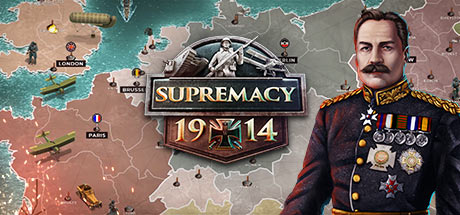Supremacy 1914 – Units Guide

Supremacy 1914 features a roster of 13 different units from the three branches: Land, Air, and Naval. Each unit type offers a set of unique features with regard to speed on different territories and strengths or weaknesses in combat with other units. To decide which unit to recruit and bring to battle, you will have to familiarize yourself with unit costs and requirements, their different battle properties, their state and behavior on different territories, and the available commands.
REGULAR UNITS
As you can see from the table below, all units have certain requirements to be met to build/recruit them. This includes certain buildings and building levels. Furthermore, since some buildings are not available before a certain day of the game, you cannot build all units from the start.
Each unit requires a certain amount of resources to produce. These systematically differ between unit types. Each unit also comes with daily upkeep that has to be afforded in order to keep the unit at full strength.
You can learn the details of each unit’s costs and requirements by clicking on the (i) icon in the production panel or on the respective unit icon in the army bar.
REGULAR UNIT COMMANDS
MOVE
To move your units, select one (left-click) or multiple units (CTRL-left click or drawing a circle around the units with the right mouse button) and drag them to their target location while holding down the left mouse button. Clicking the right mouse button while dragging will cancel the command. Alternatively, you can select the units, click the “March” button and then select the destination with a single click.
TARGET
You can add additional waypoints to an active move command or issue additional attack commands by clicking on “add target.” This feature can also be used to set custom paths for your armies which will by default use the fastest (not: shortest) route available.
DELAY
All march and attack commands can be prepared to run at a later time. In order to achieve this, click on “delay” and set the time of arrival. Regardless of the speed and starting location, units will delay their march to allow for a synchronized arrival.
MARCH
You can increase the movement speed of your troops by 50% by issuing a “forced march” command. However, they will lose 5% of their morale every hour.
SPLIT ARMIES
You can split any number of units from a given army stack by clicking on “split armies” and adjusting the sliders for each unit type accordingly, and selecting either “move” or “attack.” (Note: Armies positions on the same.
ATTACK
Dragging your army on an enemy army or city will change the move command into an attack command. Your army will start moving to the destination and will attack as soon as the enemy is in range. If an army contains ranged units (for example, Artillery), it will approach the enemy only until the unit with the highest range is in position.
SPECIAL UNITS
Special units are only available in games with unit packs enabled. In order to use them, you have to select one of the options in the section “Extra Units” when you create a new game.
AIRPLANES
Airplanes are only available in games with the “Air Pack.”
Note: Air units need an airfield to take off. They use air damage values when airborne or when stationed in a province with an airfield. Ground damage values (Fighter: 10%, Bomber: 7%) are used when on the ground without an airbase. Balloons’ mobility is limited to the routes to which all ground troops are bound.
AIRPLANE COMMANDS
PATROL
Fighters on patrol gather intelligence on enemy armies and reveal hidden units. They automatically attack enemy aircraft in the area of patrol if the latter has an active “attack” or “patrol” command. Airplanes crossing the area of patrol with a “move” command are not attacked.
ATTACK
When the command to attack is given, bombing aircraft is your goal until they are destroyed. After each attack, however, they must fly back to the base to charge new bombs.
MOVE TO ANOTHER AIRFIELD
Airplanes can only operate with an airfield in range. You can change the airfield they use for refueling by issuing a “move” command to a different airfield. If it is in flight range, the aircraft will fly to the new base – otherwise, the aircraft will be loaded on ground vehicles in order to be transported to the destination. Note: These transports are vulnerable and slow and should be avoided when enemy units are close. The diplomatic status “Shared Map” allows aircraft to use another nation’s airport as well. If the relation is set to “Right of Way,” the aircraft cannot use them and only moves on the ground.
SHIPS
While Battleships are available in normal rounds, other naval units can only be used in games with the “Air & Naval Pack” enabled. The special feature of the Submarine is that it is stealthed when not attacking (it can be made visible by patroling fighters and spies, though). The Light Cruiser is an effective alternative to the battleship. Although it is not as strong and has a shorter range, it can be built much quicker, requires fewer resources, and has a higher speed.
SHIP ABILITIES
As long as Submarines do not attack, they are invisible to the opponent. They become (and remain) visible during the battle but disappear again after the battle has been resolved.
Submarines do not have weapons for long distances. Their tarn properties make them a perfect weapon to intercept enemy battleships and land assault forces.
The psychological effect of submarine presence is not to be underestimated. Therefore, submarines are ideal for guarding coastal areas and blocking strategically important sea routes.
Use spies to detect enemy submarines. Fighters on patrol can spot enemy submarines when in range. Balloons can not.
UNIT MORALE
Unit effectiveness in battle depends heavily on its morale and mobilization (oil supply) values. Unit morale is displayed directly under each unit on the map (when hovering over it). Detailed information about unit morale, mobilization, and strength can be found in the army bar and unit details popup.
INFLUENCING FACTORS
The morale of infantry units depends on several factors:
The starting morale of a unit corresponds to the morale of the province in which they have been trained.
Units consume a certain amount of grain (20 tons per unit per day). If this supply is not met, unit morale decreases.
Units morale is affected by the morale of the province in which they are stationed. If this is low, the morale drops; if this is high, the troops’ morale will increase. Unit morale also drops on enemy territory.
For each victory over an enemy, the army will receive a small morale boost. Each loss decreases the unit’s morale a little.
MECHANICAL UNITS
In contrast to infantry, mechanical units (Artillery, tanks, armored cars, heavy tanks, railguns, battleships, aircraft, submarines, balloons) don’t have moral value but rather a condition value. Most rules affecting unit morale also apply to unit conditions when a unit is stationed on its own territory (naval units: everywhere); condition increases by ca. 17% of the difference to 100% per day.
MERGING UNITS
When merging Infantry units into one army stack, the average morale value of the original armies is obtained. When Infantry units are merged with mechanical units, the resulting morale will be the average of all morale and condition values in the army stack.

